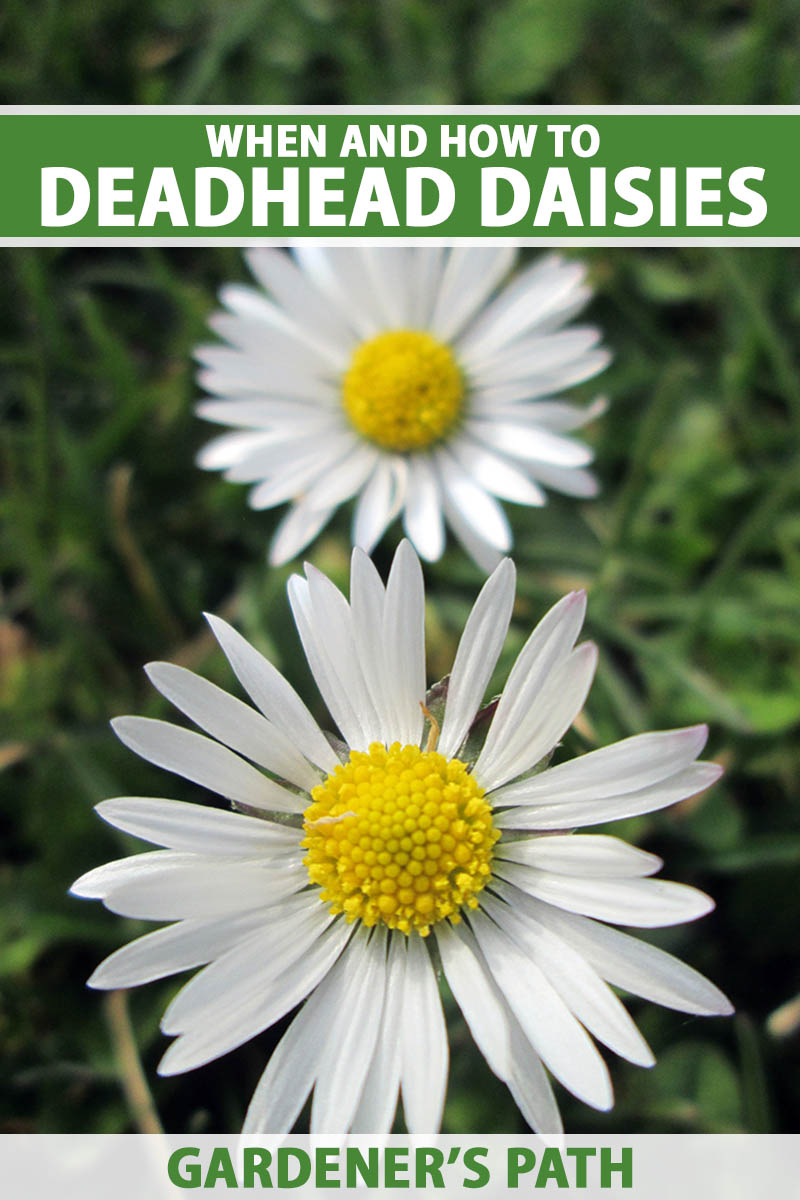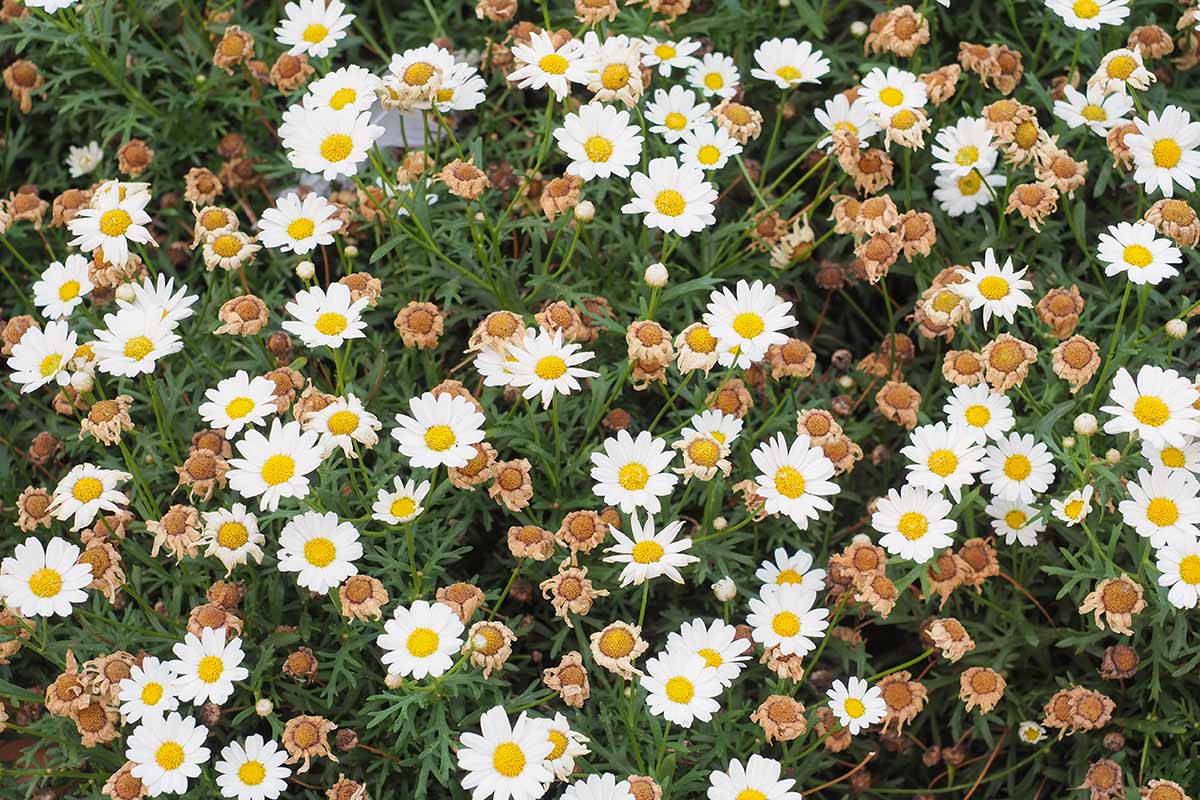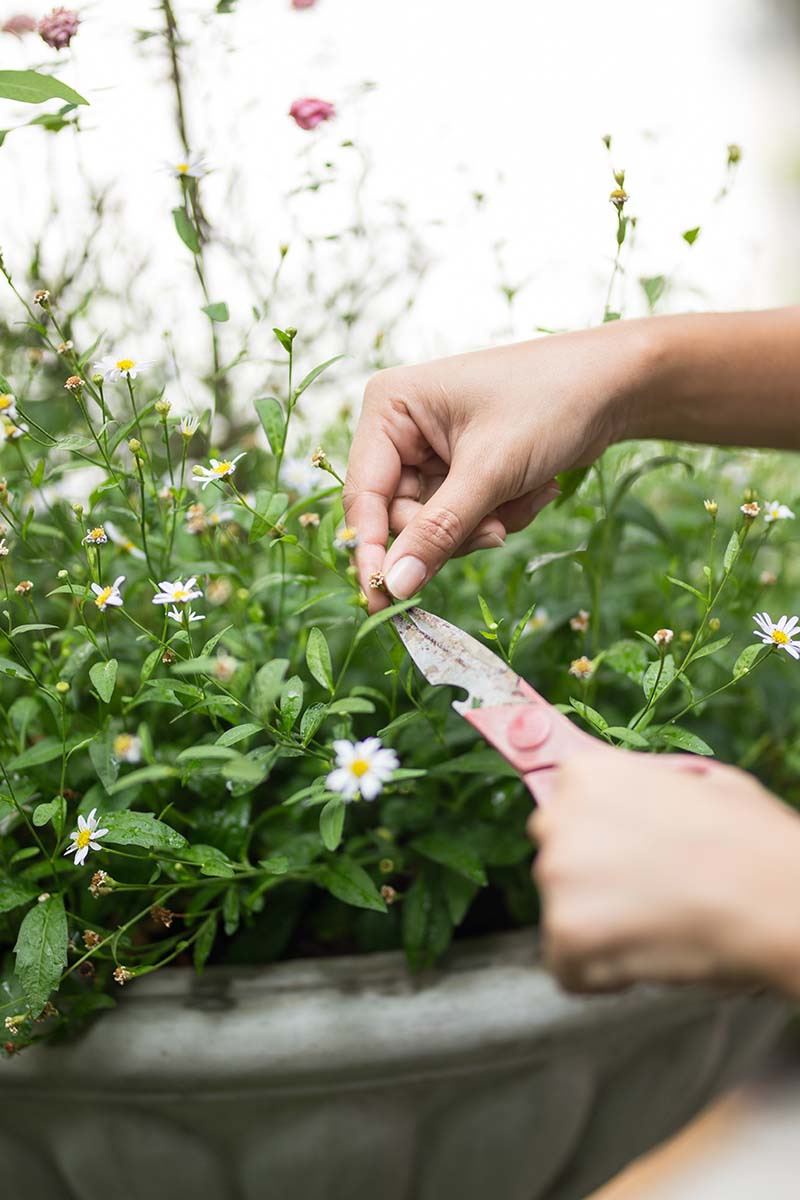They are members of the immense Asteraceae family, that includes asters, chamomile, coneflowers, coreopsis, and sunflowers. We link to vendors to help you find relevant products. If you buy from one of our links, we may earn a commission. There are native and introduced varieties for all temperate growing zones, in either annual or perennial form. Most thrive in full sun, while some tolerate partial shade. And while organically rich loam is best, many do just fine in soil of average quality. Our growing guides to various daisies have the information you need for home cultivation. In this article, we talk about a gardening task essential to keeping daisy plants looking their best: deadheading. Here’s what we’ll cover: Let’s get started!
What Is Deadheading?
After a flower blooms, it begins to fade and wither. At the end of its life cycle, it follows an innate urge to reproduce, setting and dispersing the seed its species needs to survive. As gardeners, we can manipulate a plant’s life cycle and postpone the inevitable by preventing flowers from setting seed. Deadheading is removing faded flower heads. We do it for various reasons, including to: When a flower’s reproductive cycle terminates without completion, the plant redirects its energy toward producing a new bud that can finish the job. Gardeners benefit from obtaining the most blooms a plant can produce, although they may be of reduced size after the first flush. In addition, a plant seems to stay forever young when it never displays fading or brown blooms, exhibiting an early-season attractiveness that keeps a garden looking fresh. And while a top-notch appearance is essential for a spectacular summer display, removing decaying flowers serves another purpose: It prevents insects and opportunistic pathogens from invading weak plant tissue that is vulnerable to them. And finally, pruning off spent blossoms curbs self-sowing that may cause seeds to grow in undesirable locations. Although some species, like the Shasta, spread anyway via their rootstock. We delve more into the benefits of deadheading here. Let’s look at some different flower species and then get down to the deadheading details.
Types of Daisies
While many of us picture the archetypal yellow center surrounded by white, like the characteristics presented by the common daisy (Bellis perennis), the violet-blue Swan River species (Brachyscome iberidifolia) is just as deserving of the moniker. Some, like the African (Dimorphotheca sinuata) and gerbera daisies (Gerbera jamesonii), have multiple layers of bold rays in shades of orange, red, and yellow, with brown, gold, or matching center disks. Species may be tiny, like the six- to 12-inch Blackfoot (Melampodium leucanthum), or as tall as a three-foot Montauk (Nipponanthemum nipponicum). Some, like the Montauk and Shasta (Leucanthemum x superbum), have a terminal bud that blooms first, followed by side buds. Others, such as the shrub-like daisy bush (Olearia floribunda) and spiky African wetland daisy (Ligularia spp.) produce multiple simultaneous blooms per stem. Consider the need to deadhead when you plant your favorites. You’ll have to be able to reach them with ease, whether in a pot, rock garden, or expansive drift. Be sure to read seed packets and note mature dimensions to select appropriate species and cultivated varieties to best serve your needs. And now, let’s deadhead!
How to Deadhead
Sharpen your favorite pruners, floral shears, or bonsai scissors, depending upon the thickness of the stems. Sanitize the blades in a 10 percent water to bleach solution (nine parts water to one part bleach), rinse, and dry them. The ideal time to remove blooms is when they begin to fade and droop. If you wait until they turn brown, they may set seed, bring the reproductive cycle to a close, and prevent a return to vegetative growth. Daisy Garden Gloves from Terrain Why not treat yourself to a fun pair of daisy-themed cotton garden gloves to remind you to tend your favorites? This pair from Terrain is made from canvas with a waterproof upper. It features a host of classic blooms sprinkled liberally over a mauve background. The black rubberized dots on the fingers are sure to give you a firm grip on your pruners. Find daisy garden gloves from Terrain now. One size fits most. There are two secrets to successful daisy deadheading. They are: Also, if you wait too long to prune off the dead blossoms, there might not be enough time left in the growing season for another round. Some flowers bloom intermittently throughout the summer, while others have a beautiful first flush and a not-so-showy second flush near the end of the season. Don’t hesitate to clip off those faded blooms to make the most of it. A typical daisy has stems with one terminal bud at the top of each. Each main stem may have one or more lateral or side branches that may also produce a bud. There may be a few leaves along the stem and a mound of foliage at the base of the plant. However, daisy structures vary. A new bud emerges from a “growing point.” This is a place that nature has prewired with the potential to produce a shoot and a flower. Examples are the terminal end of a lateral stem, the place where a main stem and one or a pair of leaves are joined, or at the base within the foliar mound. A better name for deadheading might be “dead stemming,” because to do it right with daisies, we need to prune off the entire stem of a spent flower, just above one of these growing points. The ideal distance is approximately a quarter of an inch – as close as possible without damaging it. Sometimes there is a new bud visible to make the job easier. If not, use the growing points as a guide. Here’s how: Use your eyes to go from the spent flowerhead down the stem. Stop just above a leaf, pair of leaves, or lateral stem. Cut just above one of these growing points. If you don’t see any of these, continue on down the stem to the basal mound of foliage and make a cut as far down as you can go without damaging the leaves. The Shasta is an example of a species we cut just above a lateral branch. The gerbera requires cutting near the bottom of its leafless, branchless main stem. Earlier, we mentioned the daisy bush and African daisy species, with multiple blossoms per stem. For these and similar species, remove entire stalks one-quarter of an inch above the base when the oldest blooms begin to fade. Not your typical daisies, these species don’t rebloom, but you may still opt to clip them for a neater appearance, fewer pest and disease issues, and no self-sowing. Whether you are working with miniatures or three-foot behemoths, look for buds and growing points. If we don’t cut at a growing point, a plant continues to feed a stem with a severed head when it should be directing its energy toward generating and/or sustaining a shoot with a flower bud. Removing spent flowers supports strong vegetative growth for exceptional roots, foliage, and blooms. It also contributes to a youthful appearance, removes debris that attracts pests and pathogens, and prevents self-sowing. Keep your pruners clean and sharp and the gardening gloves ready for flowers that are sure to delight you and summer visitors to your home. Do you have any deadheading tips to share? Let us know in the comments section below! If you found this guide useful and want to learn how to deadhead other flowers in the aster family, we suggest the following next:
How and When to Deadhead Bachelor’s ButtonsShould You Deadhead Coneflowers?Tips for Deadheading Marigolds



